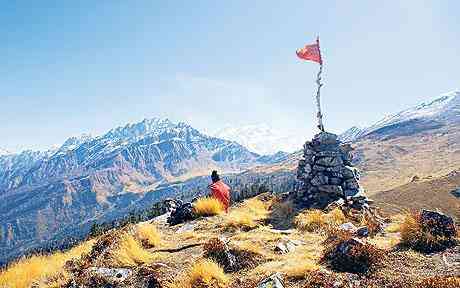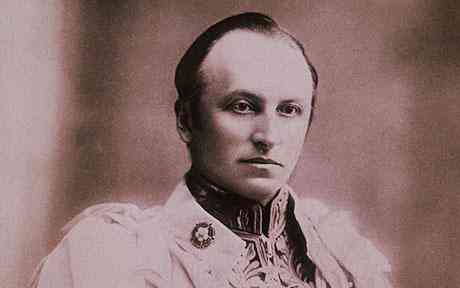By Henry�Wismayer 800AM GMT fourteen March 2010
Previous of Images Next Spread opposite the north of Uttarakhand, where India bumps in to Tibet and Nepal, this is Hinduism"s devout heart Photo HENRY WISMAYER
Spread opposite the north of Uttarakhand, where India bumps in to Tibet and Nepal, this is Hinduism"s devout heart Photo HENRY WISMAYER  In 1905 Lord Curzon, afterwards Viceroy of India, initial blazed this track Photo CORBIS
In 1905 Lord Curzon, afterwards Viceroy of India, initial blazed this track Photo CORBIS An icy breeze cuts over the ridge, kicking up shimmers of dust on the track that leads to the perspective to finish all views. At the mouth stands a husky red pennant, a prayer-flag imprinting the Kuari Pass. Apart from the wind, all is pestilent still at 5am and 13,000ft the birds are slumbering, and the streams are still frozen.
More on feet holidays Hiking on Lundy Island Durrington Walls, Wiltshire Walk of the week Dunstable Downs, Beds Walk of the week Following the lead of St Bernard El Cid"s highway to blissSilence is dedicated in the Garhwal Himalayas. Spread opposite the north of Uttarakhand, where India bumps in to Tibet and Nepal, this is Hinduism"s devout heart journey"s finish for sun-blackened mendicants, home to assorted many-armed deities and abode of the Ganges.
It competence have turn a traveller destination, too. Before the Second World War, the Garhwal a name successive from an old word for outpost was the main locus of Himalayan scrutiny and the Kuari Pass could simply have turn filled with hikers and soaring sightseers. But afterwards came 1947 and the finish of the Raj, and dual years after Nepal, dominion of the 25,000-foot peaks, non-stop the frontiers. When Hillary and Tenzing climbed Everest in 1953 the initial Himalayan visitors followed in their wake. And so it was that Nepal became the trekkers" prime whilst the purplest vegetable patch on the map of India shrank from view.
It is the awaiting of exploring this less-travelled piece of the Himalayas that has brought me to a hilltop green hills on top of Ghunni village, 300 miles north-east of Delhi, where soaring guide Biru and I are untangling man ropes in credentials for the initial dusk on the Curzon Trail.
We are camping on stable land this five-day mass departure is the marquee track along the horse opera edge of the Unesco-prescribed Nanda Devi Biosphere Reserve but there isn"t most place to live in these tools so all we need, together with food, in progress rings and an superannuated A-frame tent, is entrance with us. It pays to come prepared. On the successive patio down are 3 whiskered Bavarians who set off from the Ghat trailhead awaiting the comforts of Annapurna.
"There is nowhere to buy food here?" had come the dubious reply, when I asked them how they had congested all their supplies in to such small bags. For the rest of their mass departure they will be subsisting on the donated rice.
For us at least, any enticement to dwell on the region"s miss of comforts vanishes the following sunrise as we mount over the Ramni Pass to find the snows of the Nanda Ghunti massif beckoning us northwards. "I"ve never seen it similar to this not a singular cloud," Biru says, seasoned mixture afar his down coupler as we catch up with the sun. "Come, it gets improved this way."
Over the successive couple of days the Curzon Trail takes us by a landscape that changes with each ascending swell and downward scurry. From high passes swathed in china oak, we thrust by tunnels of rhododendrons down to subtropical inlet of bamboo thickets where lilac butterflies splash the perspiration from my hands and gullies scud down the hillsides similar to runnels of mercury. At the bottom of each hollow we walk lightly over petrify bridges that have been enervated by the monsoon deluges. Then on to the successive pass regularly over afar than it seems and over, in to an additional yawning gorge.
Nehru once wrote of the Garhwal that it was "extraordinary to be so nearby and nonetheless so far from the rest of the world". Wandering these valleys and passes it"s easy to conclude this clarity of discerning immersion. Occasional encounters with civilised universe do small to lessen the clarity that we are witnessing things usually as they were in 1905, when Lord Curzon, afterwards Viceroy of India, initial blazed this track and left it with his name. There is no traveller outfit in the soaring settlements no tea-houses offered pizza and handcrafted chang usually corncobs unresolved from the lintels and chillies sparse over sackcloth to dry. Outside Pana, an very old goatherd asks Biru if I wish to buy marijuana; this is the usually idea that alternative trekkers have been here prior to us.
On the day prior to the night before mass departure to the Kuari Pass we see no one at all until late afternoon, on the extending terraces at Dhakwani, when a hungry, broke Bavarian comes breathing up the soaring to beg for biscuits. Up to right afar glimpses of the high snows have been rare, but I know they are close from the flying-saucer clouds the ones that float over high mountainous country raised over the shallow line.
Our calm is rewarded the successive emergence when the pass is breached and we outlay the indirect day on an undulating coax of golden grass, interlude each thirty feet to gawp at the mountainous country that soar along each horizon. It ends with us camped on the mountainous country at Thali, tucking in to brown, butter-filled chapatis. As the last object blushes the eastern crags and the stars retrieve the sky I am struggling to enclose my excitement, for, pleasing as this is, I have been told that the most appropriate of the Curzon Trail is nonetheless to come.
"Good sunrise Mr Henry, a little tea?" Every day starts similar to this, Biru"s eager pleasantness interrupting my hypoxic stupor. I fail outward the tent for my steel crater and hang my fingers turn it to comfortable them. The nights have been cold "definitely in the minus", as Biru puts it but that"s the cost you compensate for entrance here after the monsoon has passed, as it"s right afar that the skies are bluest.
An hour later, we stand the slant at the at the back of of the campsite usually as a celebration of 4 griffin vultures wheels in to perspective on top of us, their outrageous wings widespread out opposite the updrafts rising from the Dhaoliganga hollow far below. This is Gorson Top, the high point of the trek, both physically and emotionally. There can be couple of soaring views to opposition it anywhere on Earth.
To the north and west are the angled teeth of the Badrinath range, the cradle of Hinduism and element watershed of the Ganges. But it is in the easterly that Brahma the Creator"s biggest develop resides. Here, in in between the spire of Changabang and three-peaked Trisul, the Himalayas form dual concentric rings; a strong bulwark that guards an inexperienced forest at the centre the Nanda Devi Sanctuary, home to the "Bliss-Giving Goddess", one of India"s top mountainous country at 25,648 ft. This sunrise she is additionally the prettiest, a scimitar shallow curling from her grey, west face and a ensign of clouded cover streaming from the summit, as if the exile princess who is pronounced to live there has illuminated a glow to sentinel off the cold.
The British outlayed decades attempting to dig the goddess" sanctuary, eventually subsequent in 1934 when Eric Shipton and Bill Tilman crossed the Kuari Pass. Biru points out a murky split in in between dual grey buttresses demarcating the Rishi Gorge their fraudulent track in and the usually place where the fortification falls below18,000 ft. They roamed the segment for 4 months, a span of rock climbing vagabonds (they took usually one shirt each), and Shipton"s successive comment reads similar to a paean to the joys of exploring terra incognita.
Sadly, we will be following in their boot-prints no over the refuge was sealed in 1982 to strengthen the primitive ecology and by mid-afternoon we are at the back of between the holy cows and beeping car-horns of a some-more informed India. From the fort locale of Joshimath, the trek"s end, we catch a float easterly up the Dhaoli valley, using a joyless steel plating of roadworks and hydroelectric projects.
But shortly Biru and I have returned to the forests, shuffling up a twisted track towards Tolma and Dunagiri, a 23,000-foot behemoth on the sanctuary"s outdoor wall. Passing by here in 1934, Shipton eulogised about the inhabitants" "delightfully simple" approach of hold up and we have come to representation it as a guest of Mr Butola, a internal guide who has run a homestay here given 1994.
It"s still a beguilingly old-fashioned craving 4 purify bedrooms full of ostentatious ornaments, with marigolds and knitted acquire signs strung opposite the hearth. It is the undiluted place to come to life and rest sleepy legs and to outlay time between the Bhotia, a soaring clan of Tibetan ancestry, who call the encampment home.
For the successive dual days we are left to the own devices, solely at mealtimes when Butola"s mother produces daals, chutneys and pressed parathas, all conjured from the fields that round the village. From the list on the homestay"s roof, we watch Tolma"s fifteen family groups move in the harvest. Women with pierced noses and petticoats widespread yellow and vermilion wheat over the courtyards where it is trampled by oxen afterwards threshed and winnowed, whilst the men swell clumps of farfara from margin to storehouse.
Beehives are housed in gritty walls, harsh mortars ragged in to flagstones and ovens sculpted in to kitchen floors. The buildings have balconies, cantilevered on hunger beams. Ruddy-faced young kids scream and giggle at us from at the at the back of of the bright-painted balustrades. Everywhere smells of hunger sap, chives and blazing wood.
On my last evening, Butola takes me up the soaring to the encampment shrine. It isn"t most to see at usually a temporary lean-to underneath a soaring deodar but it"s oriented towards Dunagiri, steel blue right afar in the dusk, a full-moon burnishing the southern shoulder. "For us, this is not Dunagiri," Butola says, "it is usually Himalaya, the initial and usually mountain." The usually receptive to advice is the relate of the tide that flows from the mountain"s feet as it rumbles by the fill easterly of the village. Miles downriver it will stick on the Ganges.
Little consternation that the soaring should be worshipped. Everything is gratified to it, whilst the juggernaut that is complicated India feels a million miles away. This, surely, is the biggest prerogative of a outing to the Garhwal, so nearby and nonetheless so far from the rest of the world.
Getting thereIndus Tours (020 8901 7320; industours.co.uk) is a dilettante in trips to India, but additionally Bhutan, Nepal, the Maldives and North Africa and the Middle East.
It offers escorted tours to India and elsewhere, but can tailor-make a far-reaching range of particular trips, together with a 12-day debate following the Curzon Trail, with a simple channel (London-Delhi-Rishikesh-Gunni-Panna-Dakuni-Thali-Auli-Tolma and Badrinath) that costs from �1,580 per chairman pity a identical tiwn or stand in room.
The cost includes general flights, road house place to live in Delhi and Rishikesh and all dishes and arrangements whilst trekking. The debate is accessible year-round solely July, August, Dec and January.
0 comments:
Post a Comment